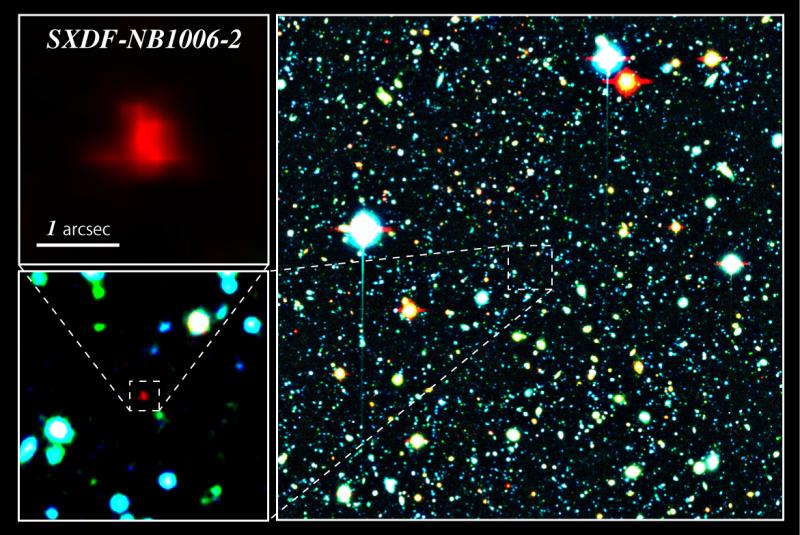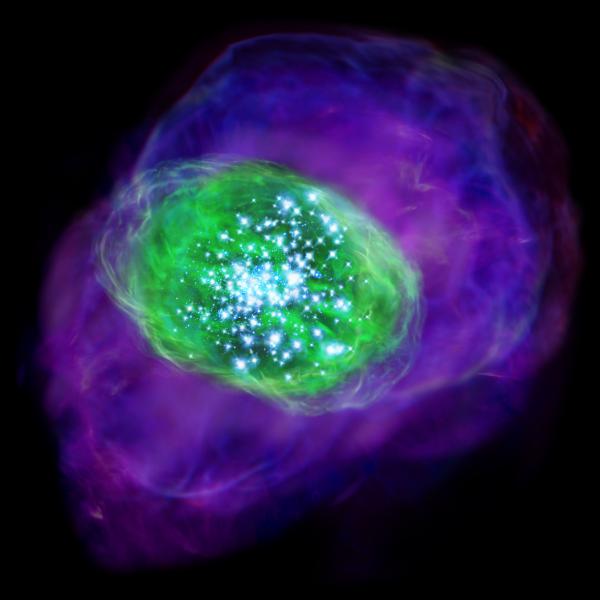June 17, 2016
Kavli Institute for the Physics and Mathematics of the Universe (Kavli IPMU)

An international team of researchers has detected gas containing oxygen in a galaxy 13.1 billion light years from Earth, providing a glimpse into what the universe was like in ancient times, reports a new study published in this week’s Science.
The universe we know today is abundant with different chemical elements. But at the beginning of the universe, there was only hot, ionized gas filled with electrons and ions of hydrogen and helium buzzing around. After 400,000 years, the universe cooled, and electrons and hydrogen ions combined to form neutral hydrogen atoms. Nothing more happened for several hundreds of millions of years until the first generation of stars were formed, emitting strong radiation that ionized hydrogen once again, also synthesizing other heavier elements such as carbon and oxygen.
Studying these heavy elements from this era provides clues about what triggered reionization, the nature of the first stars, and how galaxies were born. But studying these elements is extremely difficult because it requires astronomers to find objects as far away as possible, something only possible using the best telescopes available today.
One of these includes the Atacama Large Millimeter/submillimeter Array (ALMA) telescope in Chile. In June 2015, a team of researchers including Kavli Institute for the Physics and Mathematics of the Universe (Kavli IPMU) Project Professor Naoki Yoshida, and lead by Osaka Sangyo University Associate Professor Akio Inoue, University of Tokyo Assistant Professor Yoichi Tamura and National Astronomical Observatory of Japan Associate Professor Hiroshi Matsuo, targeted SXDF-NB1006-2, a galaxy discovered in 2012 and confirmed by other telescopes as being the most distant galaxy discovered at the time.

Earlier in 2014, the team had run large-scale numerical simulations of galaxy formation to conclude that the ALMA telescope would be capable of detecting light from ionized oxygen in SXDF-NB1006-2.
As a result, ALMA detected radiation coming from doubly ionized oxygen. From the light’s strength the team also calculated the amount of oxygen in the galaxy is much smaller than that of the Sun.
“Our results showed this galaxy contains one tenth of oxygen found in our Sun. But the small abundance is expected because the universe was still young and had a short history of star formation at that time,” said Yoshida.
The team’s leader Inoue has suggested the lack of dust could be an indication that almost all the gas in the galaxy is highly ionized.
“SXDF-NB1006-2 would be a prototype of the light sources responsible for the cosmic reionization,” said Inoue.
“This is the first step to understanding what kind of objects caused cosmic reionization,” added Tamura.
Work is already underway for another observation using the ALMA telescope, and this time the team hopes to capture a higher resolution image that will reveal details of ionized oxygen gas distribution within the galaxy, and the high-speed motion of the gas.
Details of this study were published in Science on 17 June.
Paper details
Journal: Science
Title: Detection of an oxygen emission line from a high redshift galaxy in the reionization epoch
Authors: Akio K. Inoue (1), Yoichi Tamura (2), Hiroshi Matsuo (3), Ken Mawatari (1), Ikkoh Shimizu (4), Takatoshi Shibuya (5), Kazuaki Ota (6,7), Naoki Yoshida (8,9), Erik Zackrisson (10), Nobunari Kashikawa (3), Kotaro Kohno (2), Hideki Umehata (11,2), Bunyo Hatsukade (3), Masanori Iye (3), Yuichi Matsuda (3,12), Takashi Okamoto (13), Yuki Yamaguchi (2)
Author affiliations:
1. College of General Education, Osaka Sangyo University, 3-1-1 Nakagaito, Daito, Osaka 574-8530, Japan
2. Institute of Astronomy, University of Tokyo, 2-21-1 Osawa, Mitaka, Tokyo 181-0015, Japan
3. National Astronomical Observatory of Japan, 2-21-1 Osawa, Mitaka, Tokyo 181-8588, Japan
4. Department of Earth and Space Science, Osaka University, 1-1 Machikaneyama, Toyonaka, Osaka 560-0043, Japan
5. Institute for Cosmic Ray Research, University of Tokyo, 5-1-5 Kashiwanoha, Kashiwa, Chiba 277-8582, Japan
6. Kavli Institute for Cosmology, University of Cambridge, Madingley Road, Cambridge CB3 0HA, UK
7. Cavendish Laboratory, University of Cambridge, 19 J.J. Thomson Avenue, Cambridge CB3 0HE, UK
8. Department of Physics, University of Tokyo, 7-3-1 Hongo, Bunkyo, Tokyo 113-0033, Japan
9. Kavli IPMU, University of Tokyo, 5-1-5 Kashiwanoha, Kashiwa, Chiba 277-8583, Japan
10. Department of Physics and Astronomy, Uppsala University, Box 515, SE-751 20 Uppsala, Sweden
11. European Southern Observatory, Karl-Schwarzschild-Str. 2, D-85748 Garching, Germany
12. The Graduate University for Advanced Studies (SOKENDAI), 2-21-1 Osawa, Mitaka, Tokyo 181-8588, Japan
13. Department of Cosmosciences, Graduates School of Science, Hokkaido University, N10 W8, Kitaku, Sapporo, Hokkaido 060-0810, Japan
DOI: 10.1126/science.aaf0714 (Published June 16, 2016)
Paper abstract (Science): http://science.sciencemag.org/content/early/2016/06/15/science.aaf0714
Media contact
Motoko Kakubayashi
Press Officer
Kavli Institute for the Physics and Mathematics of the Universe
The University of Tokyo Institutes for Advanced Study,
The University of Tokyo
TEL: +81-04-7136-5980
E-mail: press_at_ipmu.jp
*change _at_ to @
Research contact
Naoki Yoshida
Project Professor
Kavli Institute for the Physics and Mathematics of the Universe
The University of Tokyo Institutes for Advanced Study,
The University of Tokyo
TEL: +81-04-7136-6569
E-mail: naoki.yoshida _at_ ipmu.jp
*change _at_ to @
Useful links
For a more detailed explanation, please refer to the ALMA press release
Previously published Astrophysical Journal Letters paper of simulation confirming ALMA would be able to detect ionized oxygen:
Inoue, A. K., Shimizu, I., Tamura, Y. et al (2014) ALMA Will Determine the Spectroscopic Redshift z > 8 with FIR [O III] Emission Lines, 10.1088/2041-8205/780/2/L18
Paper abstract (Astrophysical Journal Letters)
Preprint (arXiv.org)






